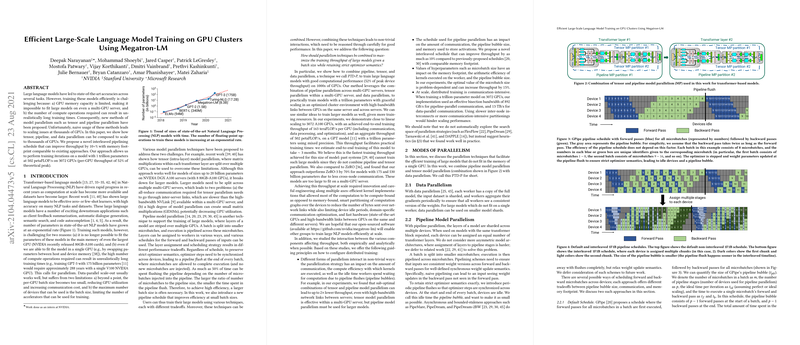Efficient Large-Scale LLM Training on GPU Clusters Using Megatron-LM
This paper presents an exploration into optimizing the training process of LLMs using novel parallelism techniques on GPU clusters. It addresses the computational and memory challenges posed by training contemporary models with up to a trillion parameters.
Context and Challenges
Training large models with transformer architectures has proven to be computationally demanding, requiring substantial GPU resources and sophisticated parallelism strategies. The complexity arises from limitations in GPU memory and the high number of compute operations necessary, impeding effective scaling when using naive parallelism approaches across multiple GPUs.
Parallelism Techniques
The paper proposes a composite parallelism strategy named PTD-P, which integrates tensor, pipeline, and data parallelism. The primary innovations and contributions are:
- Tensor, Pipeline, and Data Parallelism: This combination allows the model to leverage thousands of GPUs efficiently. Tensor parallelism is implemented within a multi-GPU server, while pipeline parallelism extends across servers to manage inter-GPU communications effectively.
- Interleaved Pipelining Schedule: A novel schedule is introduced to interleave stages, reducing pipeline flush inefficiencies, thus boosting throughput by more than 10% compared to existing approaches while maintaining comparable memory usage.
Results
The proposed methodology demonstrates commendable scaling capabilities, achieving an aggregate throughput of 502 petaFLOP/s on 3072 GPUs (equivalent to 52% of theoretical peak). The implementation achieves near-linear scaling, even with GPUs spread across 384 multi-GPU nodes. The results are particularly significant for large models such as GPT-3 and demonstrate feasible training times, estimated at around three months for a trillion-parameter model.
Analytical Insights
The paper explores the interactions between different parallelism dimensions:
- Optimal Configuration: Empirical and analytical evaluations suggest that optimal throughput is achieved when tensor parallelism is applied up to the GPU limit per node, transitioning to pipeline parallelism beyond this scope. This minimizes inter-node communication overhead.
- Microbatch Size and Hyperparameters: The choice of microbatch size critically affects performance, balancing computational intensity and pipeline bubble efficiency.
Practical Implications and Future Directions
The methods described pave the way for more efficient scaling of LLMs, which is crucial for both research and practical applications. The open-source Megatron-LM library offers a platform for further exploration into these strategies. Potential future research could explore automatic optimization of parallelism strategies to fully utilize heterogeneous hardware resources.
This work emphasizes the need to carefully integrate and balance different forms of parallelism to maximize computational resources while minimizing communication and memory bottlenecks. This foundational approach promises significant contributions to the practical application of LLMs in diverse fields, including NLP and beyond, facilitating advancements in AI with increasingly complex models.
